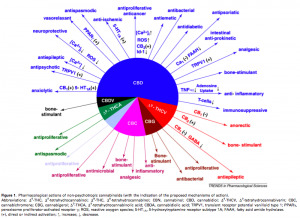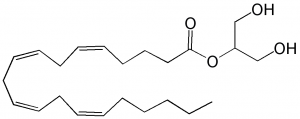
“Cannabinoids can be found in plants (phytocannabinoids), human and animal bodies (endocannabinoids) or be synthetically produced (synthetic cannabinoids). They are a class of hydrophobic chemical compounds that can stimulate cannabinoid receptors in the human body.” – Pertwee, R. G. The diverse CB1 and CB2 receptor pharmacology of three plant cannabinoids. British Journal of Pharmacology, 153: 199-215, 2008.
Phytocannabinoids
 The main quality that sets cannabis apart from all other plants is the production of cannabinoids, the phytochemicals that interact so effectively with the human endocannabinoid system.
The main quality that sets cannabis apart from all other plants is the production of cannabinoids, the phytochemicals that interact so effectively with the human endocannabinoid system.
So far, over 80 different cannabinoids have been identified in cannabis. The most common and famous of these is tetrahydrocannabinol (THC). This substance, commonly associated with recreational use of the plant, has been found to have several medical benefits.
In addition to this, cannabis contains cannabidiol (CBD), a none-psychoactive cannabinoid with anti-inflammatory, neuroprotective, anti-psychotic and other properties which make it extremely interesting to medical science.
Currently, research into the qualities and applications of CBD, THC and the other cannabinoids is taking place on a larger scale than ever before.
Endocannabinoids
The term ‘endocannabinoid‘ — originally coined in the mid-1990s after the discovery of membrane receptors for the psychoactive principle in Cannabis, Delta9-tetrahydrocannabinol and their endogenous ligands — now indicates a whole signalling system that comprises cannabinoid receptors, endogenous ligands and enzymes for ligand biosynthesis and inactivation. This system seems to be involved in an ever-increasing number of pathological conditions.
Anandamide
Anandamide is also known as N-arachidonoylethanolamine or AEA, and is an endogenous analogue of tetrahydrocannabinol, or THC. Anandamide has an effect on both the CB1 and CB2 receptors; with the CB1 receptors more affected in the central nervous system and the CB2 receptors more affected in the periphery.
Anandamide plays an important role in the regulation of appetite, pleasure and reward, and elevated levels may increase the pleasure experienced on consumption of food. Anandamide has been found in chocolate, and is thought to be partly responsible for the intense enjoyment experienced while eating it. Anandamide may also be partly responsible for pain regulation and sleep patterns.
Anandamide also has an important and as yet poorly understood role in hormonal balance and the reproductive system. During ovulation, plasma levels of anandamide are at their highest, as are levels of the sex hormones gonadotrophin and estradiol (a type of estrogen). However, it is not clear exactly what relationship these substances have with each other. Anandamide is also vital in ensuring the healthy implantation of the young embryo into the epithelium (wall) of the uterus in early pregnancy.
2-AG
 2-Arachidonoylglycerol (2-AG) is the other main endocannabinoid, that along with anandamide, has an effect on the CB receptors in the central and peripheral nervous system. Specifically, 2-AG is a full agonist of both CB receptors, and is the primary ligand (binding molecule) for the CB2 receptor.
2-Arachidonoylglycerol (2-AG) is the other main endocannabinoid, that along with anandamide, has an effect on the CB receptors in the central and peripheral nervous system. Specifically, 2-AG is a full agonist of both CB receptors, and is the primary ligand (binding molecule) for the CB2 receptor.
2-AG is the most abundant endocannabinoid found in the body, and like anandamide, is thought to play an important role in the regulation of appetite, immune system functions and pain management. It is also thought that 2-AG may also play a role in the inhibition of cancer cell proliferation.
Synthetic cannabinoids
Synthetic alternatives to phytocannabinoids have been produced for medical purposes such as Marinol, a government and FDA approved prescription medication whose active ingredient is dronabinol, a synthetic form of Δ9-tetrahydrocannabinol.
 Dronabinol is an orally active cannabinoid which, like other cannabinoids, has complex effects on the central nervous system (CNS), including central sympathomimetic activity. It is currently indicated for the treatment of anorexia associated with weight loss in patients with AIDS and nausea and vomiting associated with cancer chemotherapy in patients who have failed to respond adequately to conventional antiemetic treatments.
Dronabinol is an orally active cannabinoid which, like other cannabinoids, has complex effects on the central nervous system (CNS), including central sympathomimetic activity. It is currently indicated for the treatment of anorexia associated with weight loss in patients with AIDS and nausea and vomiting associated with cancer chemotherapy in patients who have failed to respond adequately to conventional antiemetic treatments.
There is however still a strong debate as to the effectiveness of Marinol vs the use of natural cannabinoids.

